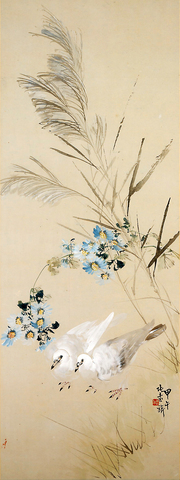The Hwa Kang Museum is up Yangmingshan, Taipei, in a corner of the Chinese Culture University campus. Established in 1971 by the university's founder Zhang Qi-yun (
This four-floor building has approximately 549m2 of
exhibition space.

PHOTO: Courtesy of the Hwa Kang Museum
The first floor gallery is open for exhibitions to both campus artists and members of the public. The third floor is set to display pieces from the museum's
permanent collections of folk arts and Chinese ceramics. The fourth floor exhibition area is designated for large-scale, semester-long thematic presentations of fine arts. The museum's permanent
collection of modern and
contemporary Chinese paintings and calligraphy contains more than 4,000 masterpieces by Chinese artists. Big-name artists include Wang Yang-ming (
In its Chinese ceramics
collection, porcelain and pottery objects are covered through the ages, from the Neolithic Yang-shao culture to the Ming and Qing dynasties.
The folk art and woodblock print collections range from aged furniture, to embroidery, woodblock prints, temple and
monastery art and Aboriginal
cultural artifacts. All these remarkable collections require at least a half-day trip for serious art lovers.
Currently on the fourth floor, curator Margaret Chen (
The late Zhang Shu-qi never set foot in Taiwan in his lifetime and is thus unknown to the general public. Yet, his outstanding skill at drawing pigeons has been lauded by the late Xu Bei-hong (
Born in 1900, Zhang painted the 3m x 3m Hundred Doves in 1941, when China was being attacked by the Japanese. Applying olive trees and azalea flowers as a background, the painting vividly depicts 100 or more doves, each with different expressions. The painting suggests the artist's desire for peace at a time when the clouds of war were gathering.
The painting was subsequently presented to former US president Franklin D. Roosevelt as a gift in commemoration of his third
presidential inauguration. It was displayed in the White House and later became part of the permanent collection of the former president's library.
Zhang was a talented landscape and birds-and-flower painter. One daring approach that Zhang adopted was to use colored Chinese painting papers, instead of normal white ones, for many of his works done in the US.
"He developed a preference for using powdered lead white and red pigment on colored paper. His colors thus became extremely eye-catching," Margaret Chen said. Fang Yi-min
(方亦民), widow of Zhang Shu-qi, donated 40 of her late husband's works to the university in 1969, after Zhang passed away in 1957.
Zhang Shu-qi expresses his desire for peace through painting doves.

In the March 9 edition of the Taipei Times a piece by Ninon Godefroy ran with the headine “The quiet, gentle rhythm of Taiwan.” It started with the line “Taiwan is a small, humble place. There is no Eiffel Tower, no pyramids — no singular attraction that draws the world’s attention.” I laughed out loud at that. This was out of no disrespect for the author or the piece, which made some interesting analogies and good points about how both Din Tai Fung’s and Taiwan Semiconductor Manufacturing Co’s (TSMC, 台積電) meticulous attention to detail and quality are not quite up to

It is one of the more remarkable facts of Taiwan history that it was never occupied or claimed by any of the numerous kingdoms of southern China — Han or otherwise — that lay just across the water from it. None of their brilliant ministers ever discovered that Taiwan was a “core interest” of the state whose annexation was “inevitable.” As Paul Kua notes in an excellent monograph laying out how the Portuguese gave Taiwan the name “Formosa,” the first Europeans to express an interest in occupying Taiwan were the Spanish. Tonio Andrade in his seminal work, How Taiwan Became Chinese,

April 21 to April 27 Hsieh Er’s (謝娥) political fortunes were rising fast after she got out of jail and joined the Chinese Nationalist Party (KMT) in December 1945. Not only did she hold key positions in various committees, she was elected the only woman on the Taipei City Council and headed to Nanjing in 1946 as the sole Taiwanese female representative to the National Constituent Assembly. With the support of first lady Soong May-ling (宋美齡), she started the Taipei Women’s Association and Taiwan Provincial Women’s Association, where she

Mongolian influencer Anudari Daarya looks effortlessly glamorous and carefree in her social media posts — but the classically trained pianist’s road to acceptance as a transgender artist has been anything but easy. She is one of a growing number of Mongolian LGBTQ youth challenging stereotypes and fighting for acceptance through media representation in the socially conservative country. LGBTQ Mongolians often hide their identities from their employers and colleagues for fear of discrimination, with a survey by the non-profit LGBT Centre Mongolia showing that only 20 percent of people felt comfortable coming out at work. Daarya, 25, said she has faced discrimination since she